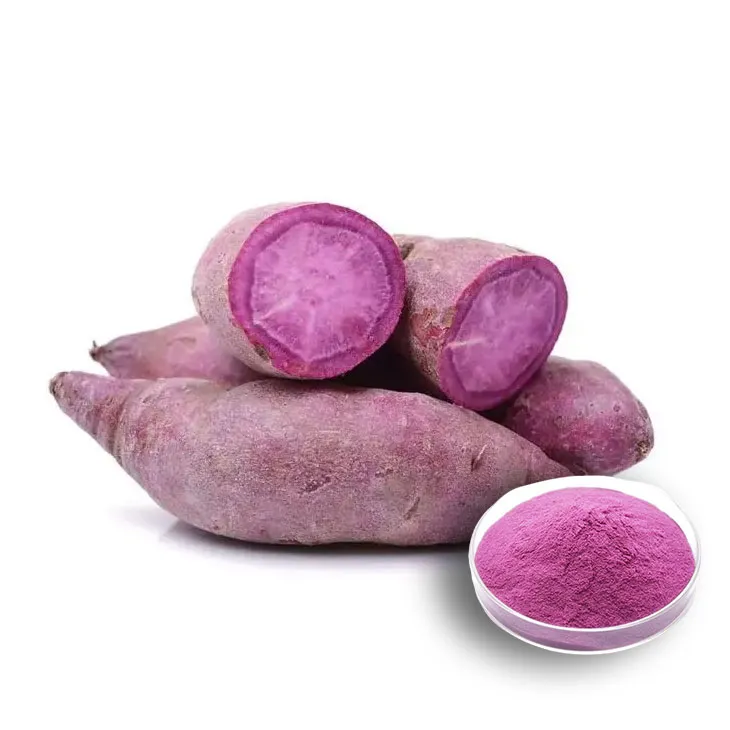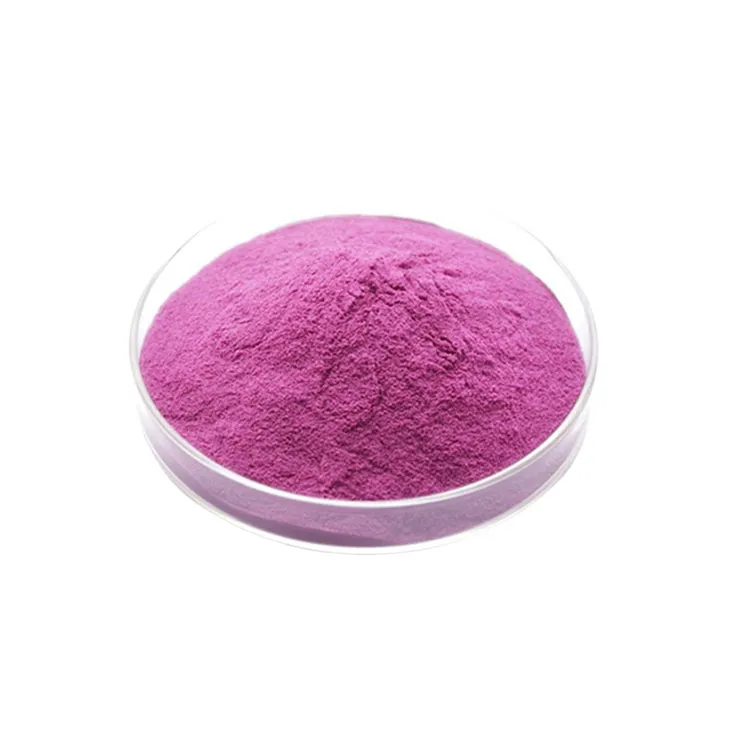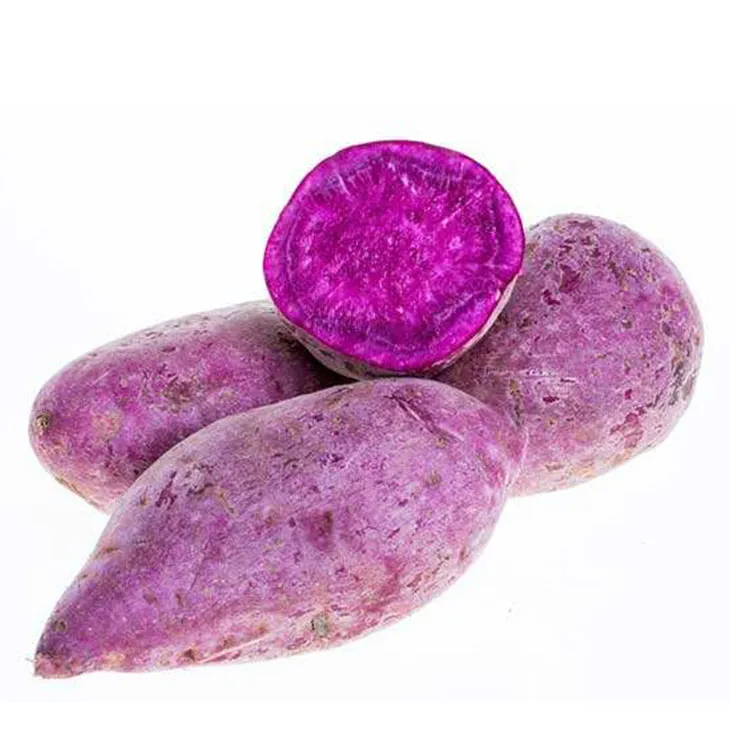- 0086-571-85302990
- sales@greenskybio.com
The Best Source of Natural Purple Sweet Potato Extract.
2024-11-26

1. Introduction
Purple Sweet Potato Extract has gained significant attention in recent years due to its numerous health - promoting properties. It is rich in anthocyanins, which are powerful antioxidants with potential benefits for human health, such as reducing the risk of chronic diseases, improving cardiovascular health, and having anti - inflammatory effects. However, the quality and quantity of the extract can vary depending on its source. Therefore, it is crucial to identify the best natural source of Purple Sweet Potato Extract.

2. The Growth Cycle of Purple Sweet Potatoes and Its Influence on Active Ingredient Concentration
2.1 Growth Stages
The growth cycle of purple sweet potatoes can be divided into several stages, including germination, vegetative growth, tuber formation, and maturation. Each stage has a distinct impact on the concentration of active ingredients in the tubers.
During the germination stage, the sweet potato plant is focused on establishing its root system and initial shoots. At this point, the concentration of anthocyanins and other active ingredients in the emerging tubers is relatively low. As the plant enters the vegetative growth stage, it is growing leaves and stems vigorously. This growth is essential for photosynthesis, which provides the energy and building blocks for the synthesis of active ingredients in the tubers. However, the tubers are still developing, and the concentration of anthocyanins continues to increase gradually.
The tuber formation stage is a crucial period for the accumulation of active ingredients. As the tubers start to form and enlarge, the plant allocates more resources to store compounds in the tubers. Anthocyanin biosynthesis is enhanced during this stage, and the concentration in the tubers begins to rise more significantly. Finally, during the maturation stage, the tubers reach their full size, and the concentration of active ingredients, especially anthocyanins, reaches its peak. Harvesting at the right time during this stage is essential to obtain purple sweet potatoes with a high concentration of active ingredients.
2.2 Environmental Factors during Growth
Environmental factors play a vital role in determining the concentration of active ingredients in purple sweet potatoes. Soil quality is one of the most important factors. Purple sweet potatoes thrive in well - drained, fertile soils rich in organic matter. Soils with a balanced pH level (around 5.5 - 7.5) are optimal for nutrient uptake and the biosynthesis of active ingredients. For example, soils that are too acidic may limit the availability of certain nutrients, such as phosphorus, which is required for the synthesis of anthocyanins.
Sunlight exposure also affects the growth and active ingredient concentration. Purple sweet potato plants require充足的 sunlight for photosynthesis. Adequate sunlight exposure promotes the production of sugars in the leaves, which are then transported to the tubers and used as precursors for the synthesis of anthocyanins. However, excessive sunlight can cause stress to the plants, which may lead to a decrease in the overall quality of the tubers. Therefore, proper shading or protection during periods of intense sunlight may be necessary in some regions.
Water availability is another crucial environmental factor. Purple sweet potatoes need consistent moisture levels throughout their growth cycle. Insufficient water can lead to stunted growth and a reduction in the synthesis of active ingredients. On the other hand, over - watering can cause waterlogging, which can lead to root rot and other diseases. Therefore, proper irrigation techniques, such as drip irrigation, are often recommended to maintain optimal soil moisture levels.

3. Organic vs. Non - Organic Purple Sweet Potato Sources
3.1 Organic Purple Sweet Potatoes
Organic purple sweet potatoes are grown without the use of synthetic pesticides, fertilizers, or genetically modified organisms (GMOs). This method of cultivation has several potential advantages when it comes to the production of Purple Sweet Potato Extract.
- Higher Purity of Extract: Since organic farming avoids the use of synthetic chemicals, the resulting purple sweet potatoes are less likely to be contaminated with pesticide residues. This can lead to a purer extract, free from potentially harmful substances that may be present in non - organic sources.
- Enhanced Nutritional Value: Some studies suggest that organic farming practices can lead to an increase in the nutritional content of crops. In the case of purple sweet potatoes, organic cultivation may result in a higher concentration of anthocyanins and other beneficial compounds. This could be due to the fact that organic soils are often richer in soil organisms and have a more balanced nutrient profile, which can promote the biosynthesis of these compounds.
- Environmental Sustainability: Organic farming is more environmentally friendly as it reduces the use of synthetic chemicals that can have negative impacts on soil, water, and wildlife. By choosing organic purple sweet potato sources, we are also supporting sustainable agricultural practices.
3.2 Non - Organic Purple Sweet Potatoes
Non - organic purple sweet potatoes are typically grown using conventional farming methods, which may include the use of synthetic pesticides and fertilizers. While these methods can increase crop yields and protect against pests and diseases, they also have some potential drawbacks.
- Pesticide Residues: The use of pesticides in non - organic farming can result in pesticide residues on the purple sweet potatoes. These residues may be transferred to the extract, which could pose a risk to human health if consumed in large quantities. However, modern pesticide regulations are in place to ensure that the levels of pesticide residues are within safe limits.
- Nutritional Differences: Some research has indicated that non - organic crops may have a slightly lower nutritional content compared to their organic counterparts. In the case of purple sweet potatoes, the concentration of anthocyanins and other active ingredients may be slightly reduced in non - organic sources. However, this difference may not be significant in all cases.

4. Post - Harvest Handling and Storage Conditions and Their Impact on Extractability
4.1 Harvesting Practices
The way purple sweet potatoes are harvested can have a significant impact on the quality of the extract. Proper harvesting time is crucial, as mentioned earlier. Harvesting too early can result in tubers with a lower concentration of active ingredients. On the other hand, delaying the harvest for too long can lead to deterioration of the tubers in the field, which can also affect the quality of the extract.
During harvesting, it is important to minimize damage to the tubers. Mechanical harvesting can be efficient, but it also has the potential to cause bruises and cuts to the tubers. These damaged areas can be a site for microbial growth and can lead to a decrease in the quality of the extract. Therefore, careful handling during harvesting, whether it is manual or mechanical, is essential.
4.2 Post - Harvest Cleaning and Sorting
After harvesting, purple sweet potatoes need to be cleaned and sorted. Cleaning helps to remove soil, debris, and any surface contaminants. This is important not only for the quality of the extract but also for preventing the introduction of foreign substances into the extraction process. Sorting is used to separate damaged or diseased tubers from healthy ones. Damaged tubers can have a lower concentration of active ingredients and may also introduce contaminants into the extraction process.
4.3 Storage Conditions
The storage conditions of purple sweet potatoes can greatly influence the extractability of beneficial compounds. Temperature is a critical factor. Purple sweet potatoes should be stored at a cool temperature, typically between 10 - 15°C. Higher temperatures can accelerate the degradation of anthocyanins and other active ingredients, while lower temperatures can cause chilling injury to the tubers.
Humidity also plays an important role. The relative humidity in the storage environment should be maintained at around 80 - 90%. Too high humidity can lead to mold growth on the tubers, while too low humidity can cause the tubers to shrivel, which can affect the extraction process.
Storage Duration is another consideration. The longer the purple sweet potatoes are stored, the more likely it is that the concentration of active ingredients will decrease. Therefore, it is advisable to process the tubers into extract as soon as possible after harvesting, especially if high - quality extract is desired.

5. Conclusion
In conclusion, the best natural source of purple sweet potato extract is one that takes into account multiple factors. Purple sweet potatoes harvested at the right stage of their growth cycle, grown in optimal environmental conditions, and with proper post - harvest handling and storage are likely to yield high - quality extract. Organic sources may offer some advantages in terms of purity and potentially enhanced nutritional value, but non - organic sources can also be a viable option if proper safety regulations are followed. Understanding these factors and their interactions can help in the selection of the best source of purple sweet potato extract for various applications, whether it is for the production of dietary supplements, functional foods, or cosmetic products.
FAQ:
Question 1: How does the growth cycle of purple sweet potatoes affect the concentration of active ingredients?
The growth cycle of purple sweet potatoes plays a crucial role in determining the concentration of active ingredients. During different stages of growth, factors such as sunlight exposure, nutrient uptake, and water availability can vary. For example, in the early growth stages, the plant is focused on establishing its root system and foliage. As it progresses towards maturity, more energy is diverted towards the development of the tubers, which is where the active ingredients are mainly stored. Adequate sunlight during the tuber - forming stage can enhance the synthesis of compounds like anthocyanins, which are important active ingredients in purple sweet potato extract. Nutrient - rich soil and proper watering also contribute to a healthy growth cycle, ensuring higher concentrations of these beneficial substances.
Question 2: What are the differences between organic and non - organic purple sweet potato sources in terms of extract quality?
Organic purple sweet potato sources are grown without the use of synthetic pesticides, fertilizers, and genetically modified organisms. This can lead to some differences in extract quality compared to non - organic sources. Organic farming practices often result in a more natural and diverse soil ecosystem, which may enhance the uptake of certain nutrients by the plants. In terms of extract, organic purple sweet potato may have a purer profile of active ingredients as it is less likely to be contaminated with chemical residues. Non - organic sources, on the other hand, may have higher yields due to the use of synthetic fertilizers, but there could be a risk of pesticide residues in the extract. However, modern agricultural practices ensure that non - organic produce also meets safety standards, and with proper processing, both can yield useful purple sweet potato extract.
Question 3: How do post - harvest handling and storage conditions impact the extractability of beneficial compounds from purple sweet potatoes?
Post - harvest handling and storage conditions are critical for the extractability of beneficial compounds. Immediately after harvest, if purple sweet potatoes are not handled properly, they can be damaged, which may lead to the degradation of active ingredients. For example, rough handling can cause bruising, which can initiate enzymatic reactions that break down compounds like anthocyanins. Storage conditions also matter. High temperatures and humidity can accelerate spoilage and reduce the concentration of beneficial compounds. Cold storage, on the other hand, can slow down these processes. Additionally, proper packaging to prevent oxygen exposure is important as oxygen can oxidize the active ingredients, making them less extractable. Maintaining optimal post - harvest conditions helps to preserve the integrity of the purple sweet potato and ensures maximum extractability of beneficial compounds.
Question 4: What are the main active ingredients in purple sweet potato extract?
The main active ingredients in purple sweet potato extract are anthocyanins. Anthocyanins are a type of flavonoid pigment that gives purple sweet potatoes their characteristic color. These compounds have antioxidant properties, which can help protect cells from damage caused by free radicals. In addition to anthocyanins, purple sweet potato extract may also contain other nutrients such as dietary fiber, vitamins (such as vitamin A, C, and E), and minerals (such as potassium). These additional components also contribute to the potential health benefits associated with purple sweet potato extract.
Question 5: How can one ensure the quality of purple sweet potato extract from different sources?
To ensure the quality of purple sweet potato extract from different sources, several steps can be taken. Firstly, for both organic and non - organic sources, it is important to verify the source's compliance with relevant agricultural and safety standards. This can involve checking for certifications such as organic certifications for organic sources. Secondly, the post - harvest handling and processing methods should be evaluated. This includes ensuring proper storage conditions, as mentioned earlier, and using appropriate extraction techniques. Thirdly, laboratory testing can be carried out to analyze the concentration and purity of the active ingredients. This can help in comparing different extracts and ensuring that they meet the desired quality standards for use in various applications, such as in the food, cosmetic, or pharmaceutical industries.
Related literature
- The Composition and Health - Promoting Properties of Purple Sweet Potato Extract"
- "Growth Factors Affecting Purple Sweet Potato Active Ingredient Concentration"
- "Organic vs. Non - Organic Purple Sweet Potato: A Comparative Study on Extract Quality"
- "Post - Harvest Management of Purple Sweet Potatoes for Optimal Extract Production"
- ▶ Hesperidin
- ▶ citrus bioflavonoids
- ▶ plant extract
- ▶ lycopene
- ▶ Diosmin
- ▶ Grape seed extract
- ▶ Sea buckthorn Juice Powder
- ▶ Beetroot powder
- ▶ Hops Extract
- ▶ Artichoke Extract
- ▶ Reishi mushroom extract
- ▶ Astaxanthin
- ▶ Green Tea Extract
- ▶ Curcumin Extract
- ▶ Horse Chestnut Extract
- ▶ Other Problems
- ▶ Boswellia Serrata Extract
- ▶ Resveratrol Extract
- ▶ Marigold Extract
- ▶ Grape Leaf Extract
- ▶ blog3
- ▶ blog4
-
Chinese Withania somnifera Extract Factory.
2024-11-26
-
中国松树皮提取物粉粉末供应商
2024-11-26
-
High - quality Marigold Extract Products.
2024-11-26
-
100% Pure Natural Mango - Flavored Powder.
2024-11-26
-
Fig Extract
2024-11-26
-
Purple Sweet Potato Extract
2024-11-26
-
Dan Shen Root Extract/Salvia Root Extract
2024-11-26
-
Green coffee bean Extract
2024-11-26
-
Coix Seed Extract
2024-11-26
-
Camu Camu Extract
2024-11-26
-
Stevia Extract
2024-11-26
-
Aminolevulinic acid
2024-11-26
-
Polygonum Cuspidatum Extract
2024-11-26
-
Soy Extract
2024-11-26




















